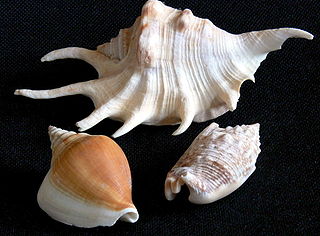Related Research Articles

Strombidae, commonly known as the true conchs, is a taxonomic family of medium-sized to very large sea snails in the superfamily Stromboidea, and the Epifamily Neostromboidae. The term true conchs, being a common name, does not have an exact meaning. It may generally refer to any of the Strombidae but sometimes is used more specifically to include only Strombus and Lambis. The family currently includes 26 extant, and 10 extinct genera.

Strombus is a genus of medium to large sea snails, marine gastropod molluscs in the family Strombidae, which comprises the true conchs and their immediate relatives. The genus Strombus was named by Swedish Naturalist Carl Linnaeus in 1758. Around 50 living species were recognized, which vary in size from fairly small to very large. Six species live in the greater Caribbean region, including the queen conch, Strombus gigas, and the West Indian fighting conch, Strombus pugilis. However, since 2006, many species have been assigned to discrete genera. These new genera are, however, not yet found in most textbooks and collector's guides.

Georissus, also called minute mud-loving beetles, is the only genus in the beetle family Georissidae. They are tiny insects living in wet soil, often near water. They are found on every continent except Antarctica.

The Stereocaulaceae are a family of lichen-forming fungi in the order Lecanorales. It contains five genera. Species of this family are widely distributed in temperate boreal and austral regions.
Rechingeriella is a genus of fungi in the family Zopfiaceae; according to the 2007 Outline of Ascomycota, the placement in this family is uncertain.
Zopfia is a genus of fungi in the family Zopfiaceae. The widespread genus contained 5 species, until another species was accepted.
The Asterinaceae are a family of fungi in the class Asterinales.

Lobatus is a genus of very large sea snails, marine gastropod mollusks in the family Strombidae, the true conchs. Some of the species within this genus were previously placed in the genus Eustrombus.
Actinopeltis is a genus of fungi in the Trichothyriaceae family.
Maublancia is a genus of fungi in the Microthyriaceae family.
Seynesiella is a genus of fungi in the Microthyriaceae family.
Cirsosia is a genus of fungi in the Asterinaceae family. The relationship of this taxon to other taxa within the class is unknown, and it has not yet been placed with certainty into any order.
Morenoina is a genus of fungi in the Asterinaceae family. The relationship of this taxon to other taxa within the class is unknown, and it has not yet been placed with certainty into any order.
Trichasterina is a genus of fungi in the Asterinaceae family. The relationship of this taxon to other taxa within the class is unknown, and it has not yet been placed with certainty into any order.
Gabarnaudia is a genus of anamorphic fungi that was placed in the family Ceratocystidaceae, until phylogenetic analysis by Hausner and Reid (2004) and De Beer et al. (2013a) showed that Gabarnaudia fimicolaG. betae and G. humicola clustered within genus Sphaeronaemella.
Sporendocladia is a genus of anamorphic fungi in the family Ceratocystidaceae. The widespread genus contains seven species.
Phallus flavocostatus is an East Asian species of fungus in the stinkhorn family. First described as Ithyphallus costatus by Otto Albert Julius Penzig in 1899, it was transferred to the genus Phallus by Curtis Gates Lloyd in 1909. It was given a new name by Hanns Kreisel in 1996.
Ooperipatus is a genus of Australian velvet worms in the Peripatopsidae family. All species in this genus are oviparous and have 15 pairs of oncopods (legs).

Aspidoscelis costatus, also known as the western Mexico whiptail, is a species of whiptail lizard endemic to Mexico, including Guerrero, Morelos, and Puebla in southern Mexico, as well as other Mexican states. Its range spans both temperate and tropical habitats, and even densely populated urban areas. Its common name, the Western Mexico Whiptail, can easily be confused with the Western Whiptail, which refers to a different lizard, Aspidoscelis tigris.
Rhagadostoma is a genus of fungi in the family Nitschkiaceae. All species in the genus are lichenicolous, meaning they live parasitically on lichens.
References
- ↑ "Synonymy: Akenomyces G. Arnaud ex D. Hornby". Species Fungorum. CAB International. Retrieved 2014-05-18.
- ↑ Hornby D. (1984). "Akenomyces costatus sp. nov. and the validation of Akenomyces Arnaud". Transactions of the British Mycological Society. 82 (4): 653–64. doi:10.1016/s0007-1536(84)80106-0.